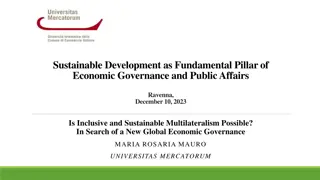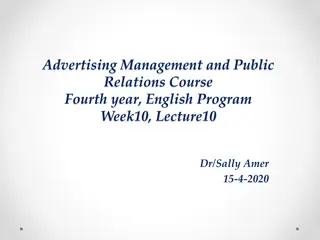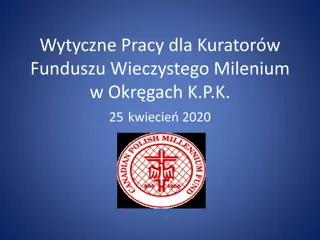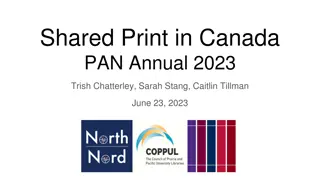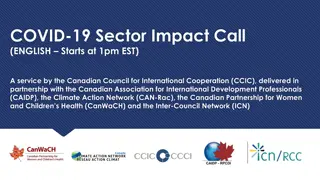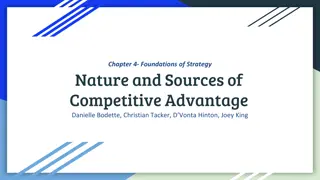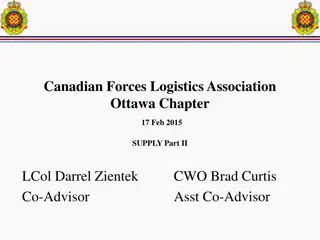Sustainable Competitive Advantages in the Canadian Lentil Industry
The Canadian lentil industry holds a significant position in the global market, with key production in Saskatchewan. The sector faces challenges related to plant genetics appropriation. Investments in research and development, alongside access to new varieties, impact yields and economic outcomes. The potential economic impacts of other countries like Russia and Kazakhstan acquiring and planting new lentil varieties are explored, highlighting the importance of strategic solutions for maintaining competitive advantages in the industry.
Download Presentation

Please find below an Image/Link to download the presentation.
The content on the website is provided AS IS for your information and personal use only. It may not be sold, licensed, or shared on other websites without obtaining consent from the author. Download presentation by click this link. If you encounter any issues during the download, it is possible that the publisher has removed the file from their server.
E N D
Presentation Transcript
Sustainable Competitive Advantages in the Canadian Lentil Industry: A Case Study Eric T. Micheels, Alison Sawka and Richard Gray WERA-72 Annual Meeting Santa Clara, California July 1, 2014 www.usask.ca
Motivation Canada major player in global lentil market 30% of global production (FAOSTAT, 2012) 57% of world exports (FAOSTAT, 2011) 95% of Canadian production occurs in Saskatchewan Lentil exports are generally whole lentils Issue: Plant genetics can be appropriated www.usask.ca
Top Five Lentil Producing Countries, 2012 1,600,000.00 1,400,000.00 Production (Tonnes) 1,200,000.00 1,000,000.00 800,000.00 600,000.00 400,000.00 200,000.00 0.00 United States of America 240,490.00 Canada India Australia Turkey Production 1,493,620.0 950,000.00 463,000.00 438,000.00 www.usask.ca
Overview of Sask Lentil Value Chain Saskatchewan Pulse Growers University of Saskatchewan Crop Development Centre Domestic Buyers Select Seed Growers Growers Processors International Buyers www.usask.ca
Investment and Yields in Lentils SPG collects a 1% non-refundable levy on all lentils marketed in Canada 2012 production 1.5 M tonnes Prices of lentils ~ $480/tonne Invested in R&D New CRL varieties show yield increases ~3% per year Through agreement with CDC, producers have royalty free access to new varieties www.usask.ca
Lentil and Wheat index yields (1984-2011) www.usask.ca
Issue? What if other countries where growing conditions are similar are able to acquire and plant the new varieties? Russia and Kazakhstan What is the economic impact? Are contracts a solution? www.usask.ca
Hypothetical States Developed four scenarios of increased production in Russia and Kazakhstan Acreage relative to spring wheat 5%; 2.5%; 1.25%; no change Result: There was not that much incentive to develop a closed-loop value chain to split lentils (mechanical protection) www.usask.ca
Findings from IP Study From 2014-2034, an additional 92 million $CAD in producer surplus is gained through protection of IP. Break-even processing margin is $3.41/tonne www.usask.ca
Resource Based View Firms (and organizations) are bundles of resources Penrose (1959) Resources can create SCA when: Valuable Rare Imperfectly imitable Non-substitutable www.usask.ca
SCA in Canadian Lentil Industry? Leakage of genetics a problem, just not one that is not that economical to fix Value is in process to create genetics, not the genetics themselves Social complexity Causal ambiguity Time compression diseconomies www.usask.ca
Sustainable vs. Temporary advantages How much is the industry willing to spend to protect a temporary advantage? Lagged effect Multi-stakeholder engagement? www.usask.ca
Solutions? 1. Contracts Growers must deliver to certain processors who will split lentils 2. Plant Breeder s Rights Genetics protected from appropriation in certain jurisdictions 3. Something else? www.usask.ca
Results and Discussion Cost of leakage of genetics is real Cure may be worse than the disease Sustainable versus temporary advantages Relationships between SPG, U of S, CDC create and sustain value www.usask.ca
QUESTIONS/COMMENTS Acknowledgement: Project was funded by the Saskatchewan Pulse Growers Contact Info: Eric T. Micheels eric.micheels@usask.ca Richard Gray richard.gray@usask.ca www.usask.ca










